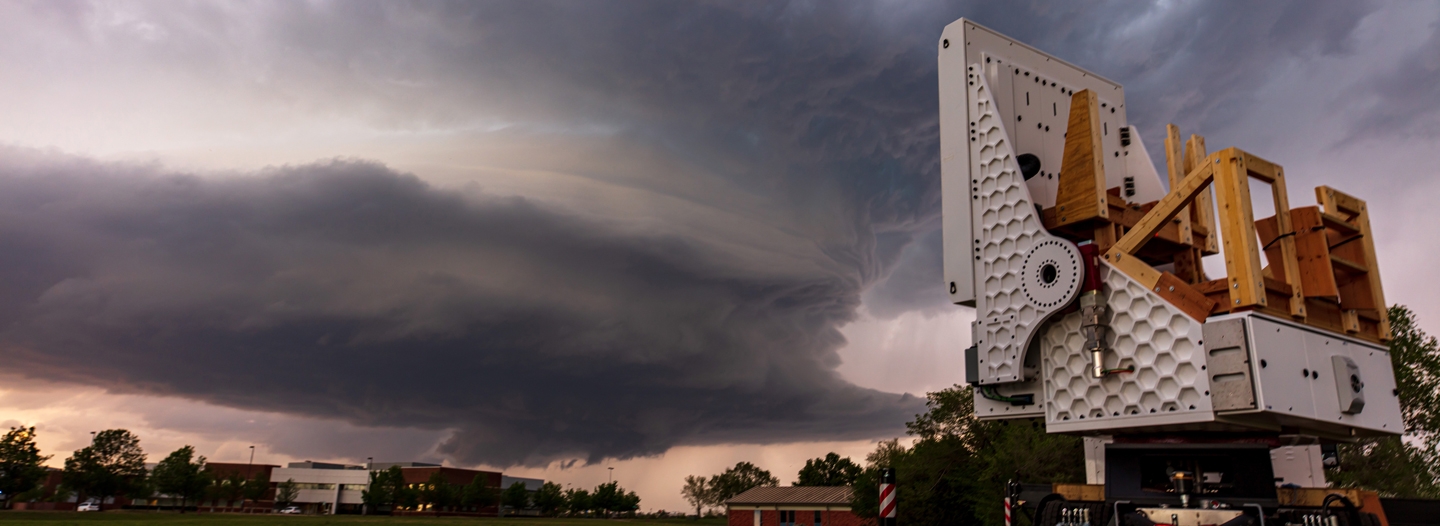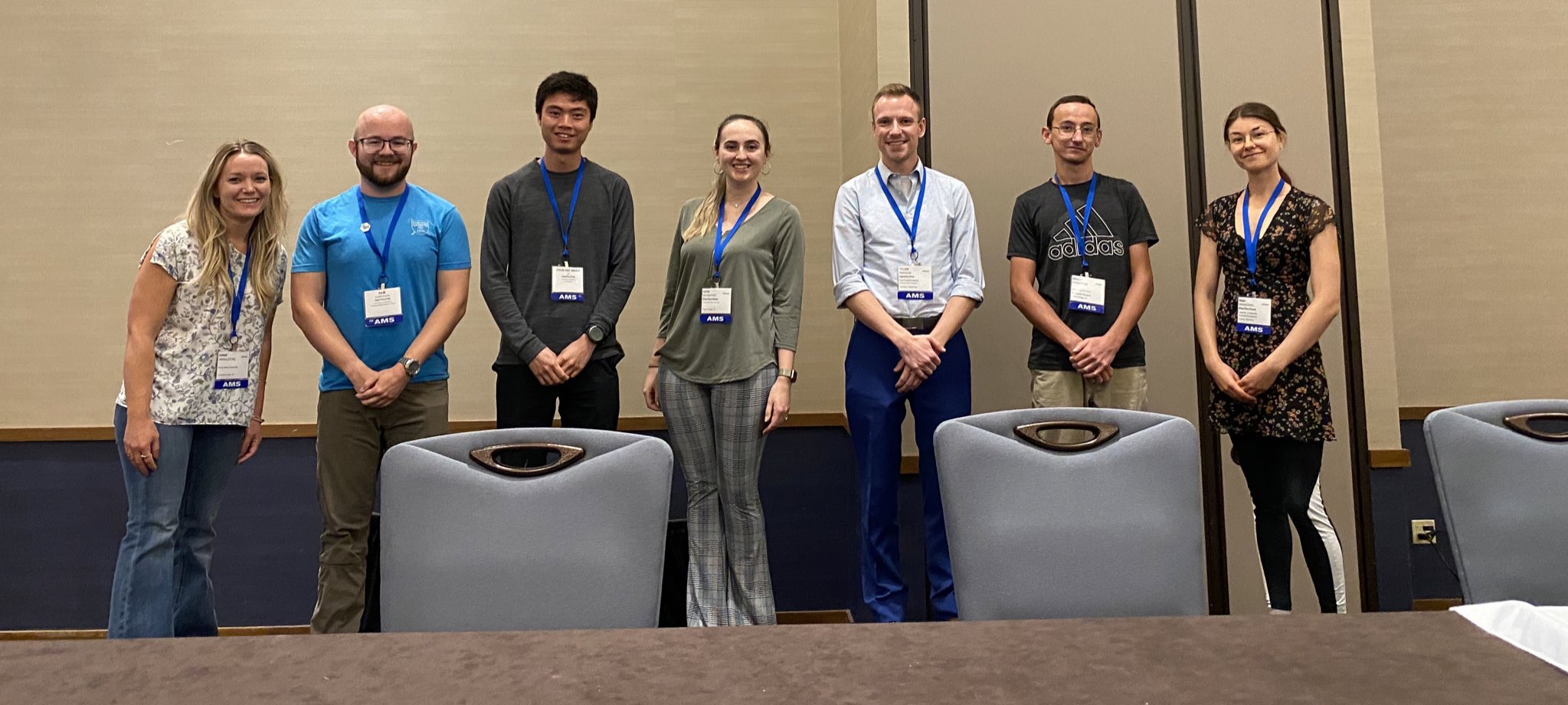News Archive

The University of Oklahoma has developed and now deployed the most advanced weather radar in the world. Led by a team of engineers and weather experts, and with funds from NOAA’s National Severe Storms Laboratory, the Advanced Radar Research Center at OU has launched "Horus," an all-digital polarimetric phased array radar capable of obtaining data with unprecedented quality and temporal resolution to help understand and predict the formation of severe weather. Click here to read entire article.

The ARRC and Epirus, Inc. have been awarded an $8.16 million Office of Naval Research grant to develop breakthrough long-distance phased array applications. The grant was awarded for joint effort to maximize output power of phased arrays for enhanced operational ranges utilizing AI and digital twin best practices. Click here to read full article.

Congratulations to SoM/ARRC graduate student Sam Emmerson (second from left) for receiving 3rd place in the poster contest at the AMS 40th Conference on Radar Meteorology, held recently in Minneapolis, MN. Sam's poster highlighted his research on the validation of multistatic wind retrievals using a vertical pointing mobile radar. (S.W. Emmerson, R.D. Palmer, D.J. Bodine, D. Schvartzman, P. Kirstetter, and P.S. Skinner, 2023: Validation of Multistatic Wind Retrievals Using a Vertically Pointing Mobile Radar. 40th Conf. on Radar Meteorology, Minneapolis, MN, Amer. Meteor. Soc., P74.)

The ARRC recently hosted a casual barbecue to honor Dr. Kelvin Droegemeier who is leaving OU for the University of Illinois. Kelvin was instrumental in starting the Radar Initiative that led directly to the establishment of the ARRC in 2005. We appreciate his continued support of the ARRC over the years and wish him the very best in his new endeavor.

Bob Palmer and Tian Yu recently visited the Korean Meteorological Administration (KMA) in Seoul. Discussions centered around the future of weather radar and recent advances in radar signal processing.
Pictured between Drs. Palmer and Yu is Young Youn Park, Director General of the KMA Weather Radar Center.

After several years of diligent effort by the ARRC team and in collaboration with NOAA colleagues, the first journal paper on the fully digital Horus Phased Array Radar was published in the latest IEEE Transactions on Radar Systems (Volume 1) in the special section on fully digital arrays. The technology represented in Horus will help advance weather radar science for decades to come.
Read the full journal article here.

Min-Duan Tzeng is a Ph.D. student in the School of Electrical and Computer Engineering, advised by Dr. Tian Yu and Dr. David Bodine.
How long have you been part of the ARRC:
"It has been about two and half years that I have been at the ARRC."
Any scholarships/journal awards/publications ect. that you have received:
• Government Scholarship to Study Abroad from Taiwan Ministry of Education, 2021-2024
Current Research:
"I am currently working on a project that involves the application of spectral polarimetry for observing thunderstorms and atmospheric electricity. Additionally, I am developing a polarimetric radar spectrum simulator that incorporates both transmission and receiving polarization flexibility."
What do you like to do in your free time:
"I play tennis, video games and board games with friends."
Plans for after graduating:
"I plan to apply for positions in a radar research facility as a software or system engineer specializing in system development and signal processing."

Dr. David Schvartzman, SoM Assistant Professor and member of the ARRC, received the “2022 IEEE R5 Outstanding Young Professional” Award. This award is designed to recognize those substantive projects or achievements of a relatively short nature but which have left an undeniable imprint on the fabric of Young Professionals.
David received the award in recognition of his effort to advance dual-polarization phased array radar technology for meteorological observations. He was nominated for his development of waveforms, custom beam patterns, scanning strategies and algorithms to advance polarimetric phased array radar technologies for weather observations. David also developed numerous signal processing and polarimetric calibration algorithms, to bring the data produced by phased array radars beyond quality standards of current operational weather radar networks. He has more than 25 co-authored journal publications, more than 100 co-authored conference papers, and has achieved the IEEE Senior Membership. He is also the current chair of the IEEE OKC Young Professionals Affinity Group.

Justin Metcalf, Ph.D., assistant professor in the School of Electrical and Computer Engineering, Gallogly College of Engineering, and an affiliate faculty in the Advanced Radar Research Center at the University of Oklahoma, has received the 2023 Fred Nathanson Memorial Radar Award from the Aerospace and Electronic Systems Society of the Institute of Electrical and Electronics Engineers for his contributions to radar embedded communications, spectrum sharing, and cognitive radar.
The competitive international award recognizes "individual contributions to the radar community through technical papers, presentations, inventions or products" and is selected by committee members of the IEEE Aerospace and Electronic Systems Society Radar Systems Panel. The award began in 1985. Metcalf is the first U.S. recipient since 2019 and the sixth U.S. recipient over the past 20 years. Click Here to read more.